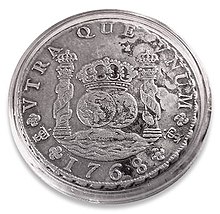Spansk real
 For alternative betydninger, se Real.
For alternative betydninger, se Real.


Real (engelsk: /ɹeɪˈɑl/ spansk: /reˈal/) (betyder: "kongelig", flertal: reales) var en valutaenhed i Spanien i flere århundreder efter midten af det 14. århundrede.[1][2] Real gennemgik adskillige værdiændringer i forhold til andre enheder gennem hele sin levetid, indtil den blev erstattet af pesetaen i 1868. Den mest almindelige pålydende værdi for valutaen var en otte-real spanske sølvdollar eller peso, som blev brugt hele vejen igennem Europa, Amerika og Asien under det spanske imperiums højdepunkt.
Anvendelse i USA
[redigér | rediger kildetekst]
I en periode blev bl.a. den spanske otte real-sølvmønt anvendt i USA indtil 1780'erne, da amerikanske dollar blev indført. Da otte real-sølvmønten i USA var for stor til mange handler, blev mønten klippet i ca. fjerdedele eller ottendedele stykker. En ottendedel blev kaldt en bit.[3][4][5]
Referencer
[redigér | rediger kildetekst]- ^ Martínez, Mary (10. februar 2017). "Spanish influence on American Currencies". Kind-le. Arkiveret fra originalen 7. oktober 2017. Hentet 17. juli 2018.
- ^ lex.dk: real, backup Citat: "...Real, (sp., af lat. regalis 'kongelig', af rex 'konge', gen. regis), spansk sølvmønt, indført midt i 1300-t. og efterfulgt af dobbelte og fra 1497 af fire- og otterealer..."
- ^ Oct 4, 2014, huffpost.com: Where Did That Money Come From?, backup Citat: "...most people about forty years and younger do not have any idea what "two bits" or "four bits" or "six bits" or any number of bits refer to. By William B. Bradshaw, Contributor...Coins of lesser value than the Spanish dollar were in short supply in the new country. When coins of lesser value were needed as change to balance out a purchase, it was common practice for a merchant actually, with a small axe or cutting tool, to chop or cut a piece of eight (the Spanish dollar coin) into eight equal smaller "bits," each bit being worth one-eighth of the Spanish dollar. Hence, "two bits" was worth one-quarter of a dollar, "four "bits" was equal to one-half of a dollar, and so forth. And the people actually called these small pieces of chopped-up coins "bits."..."
- ^ August 15, 2018, coinweek.com: History of Coins – TWO-BITS, FOUR-BITS, SIX-BITS, EIGHT…, backup Citat: "...The most widely circulated of these was the piece of eight, which, when supplies of smaller denomination coins dwindled were chopped or cut into smaller pieces to make change. Thus, one eighth of eight-reales became one bit, one quarter two-bits–the equivalent of our present day quarter-dollar. One-half is four-bits and three quarters are six-bits. Many believe these expressions to be slang, yet, history suggests they are perfectly good nomenclature...When making plans for a monetary system, the United States considered using one similar to the real system. This was because it was the most common system used in the USA at the time, and was familiar to most citizens. A system based on the piece of eight was agreed to and renamed “dollar” in the 1780s..."
- ^ seahistory.org: SEA HISTORY for Kids, backup Citat: "...Colonists in British North America were not allowed to mint money of their own, even though they often ran out of English coins to use in day-to-day business. Instead, they resorted to using whatever coinage they could get their hands on. The most common coin used during this time was the silver Spanish dollar, which was worth 8 “reales,” a unit of currency in Spain...Back then, coins were valued by their actual weight in silver or gold, not just on what they looked like. Spanish coins were preferred over other currency because they had a milled, or patterned, edge, which prevented dishonest traders from shaving slivers off the coins without being detected. Cutting money was not illegal, like it is now. In fact, it was expected that, to make change, they literally cut the coins into 8 pieces or “bits.”..."
Eksterne henvisninger
[redigér | rediger kildetekst]- Coins from Guadalajara, Jalisco. Mexico (1812–2006) at gdlcoins.com (archived 28 April 2018)
- The Colonial Coinage of Spanish America: An introduction by Daniel Frank Sedwick
- Coins of Spanish Real at Numista
